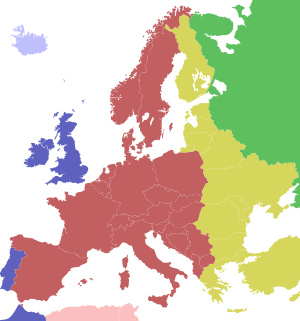- Further-eastern European Time
-
 Time zones of Europe:
Time zones of Europe:
Light colours indicate countries that do not observe summer time: Algeria, Belarus, Iceland, Russia, Tunisia.blue Western European Time (UTC+0)
Western European Summer Time (UTC+01:00)light blue Western European Time (UTC+0) red Central European Time (UTC+01:00)
Central European Summer Time (UTC+02:00)yellow Eastern European Time (UTC+02:00)
Eastern European Summer Time (UTC+03:00)orange Further-eastern European Time (UTC+03:00) light green Moscow Time (UTC+04:00) Further-eastern European Time (FET) (Kaliningrad Time in Kaliningrad Oblast in Russia, Minsk Time in Belarus) is since September 2011 defined as three hours ahead of UTC (UTC+03:00). It was established as the official time for the Russian Kaliningrad Oblast and then followed by Belarus.
History
Until 2011, Further-eastern European Time was identical to Eastern European Time (UTC+2; UTC+3 with daylight saving time). However, on 27 March 2011, Russia moved to the so called "year-round daylight saving time"[1], so that clocks would remain on what had been the summer time all year round, making Kaliningrad Time permanently set to UTC+3, peculiarly placing its time ahead of countries to its east during winter. Belarus followed Russia on September 15, 2011[2], and the same decisions was made by the Ukrainian parliament on September 20, 2011[3]. After strong criticism from the mass media, on 18 October 2011 the Ukrainian parliament cancelled its previous decision[4]. Transnistria, a breakaway territory from Moldova on the Dniester river bordering Ukraine, followed Ukraine by at first adopting Further-eastern European Time[5] but later cancelling this decision[6].
The name "Further-eastern European Time" seems to have come from work on tzdata, the Unix time zone database.[7][8]
See also
- Time zone
- UTC+03:00
References
- ^ Russia Time Change
- ^ Eternal Daylight Saving Time (DST) in Belarus
- ^ Ukraine cancels use of daylight saving time, Kyiv Post (September 20, 2011)
- ^ "Ukraine to return to standard time on Oct. 30 (updated)". Kyiv Post. 18 October 2011. http://www.kyivpost.com/news/nation/detail/115146/. Retrieved 18 October 2011.
- ^ Transnistria stays on Daylight Saving Time
- ^ Transnistria's clocks move back October 30, 2011
- ^ Edwin Groothuis, at freebsd.org (27 Sep 2011). "cvs commit: ports/misc/zoneinfo Makefile distinfo". http://www.mail-archive.com/cvs-all@freebsd.org/msg202018.html. Retrieved 16 Oct 2011.
- ^ Alexander Bokovoy, employed at Red Hat Software (Sep 21, 2011). "Дальневосточное Европейское время" (in Russian). https://plus.google.com/u/0/117200318980623167325/posts/TgF6UsrATGx. Retrieved 16 Oct 2011.
Categories:- Time zones
- Standards and measurement stubs
- Belarus stubs
Wikimedia Foundation. 2010.
